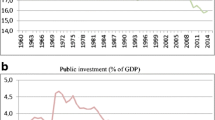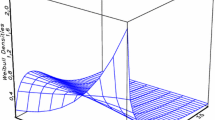Abstract
Mancur Olson's institutional sclerosishypothesis may be evident in the effects ofinterest groups on investment in physicalcapital. To test this proposition, we usecross sectional data on 42 countries forwhich information on the number of interestgroups is available to estimate the effectof those groups on the share of GDP thatgoes into physical investment. The resultsindicate that interest groups have adifferent effect on physical investment inOECD and non-OECD countries. In the OECDcountries, we find support for thehypothesis that interest groups harminvestment in physical capital. Indeveloping countries, interest groupseither have no effect on physicalinvestment or they have a slight beneficialimpact.
Similar content being viewed by others
References
Barro, R. (1997). Determinants of economic growth: A cross-country empirical study. Cambridge, MA: MIT Press.
Barro, R. and Lee, Jong-wha (1993). International comparisons of educational attainment. Journal of Monetary Economics 32: 363–394.
Coates, D. and Heckelman, J.C. (2003). Absolute and relative effects of interest groups on the economy. In J.C. Heckelman and D. Coates (Eds.), Collective choice: Essays in honor of Mancur Olson. Berlin: Springer-Verlag.
Gray, V. and Lowery, D. (1988). Interest group politics and growth in the U.S. states. American Political Science Review 82: 109–131.
Heckelman, J.C. (2000). Consistent estimates of the impact of special interest groups on economic growth. Public Choice 104: 319–327.
Knack, S. (2002). Groups, growth and trust: Cross-country evidence on the Olson and Putnam hypotheses. Paper presented at the Public Choice Society Meetings, San Diego, CA.
Knack, S. and Keefer, P. (1997). Does social capital have an economic payoff? A cross-country investigation. Quarterly Journal of Economics 112: 1251–1288.
McCallum, J. and Blais, A. (1987). Government, special interest groups, and economic growth. Public Choice 54: 3–18.
Murrell, P. (1984). An examination of the factors affecting the formation of interest groups in OECD countries. Public Choice 43: 151–171.
Olson, M. 1982. The rise and decline of nations: Economic growth, stagflation, and social rigidities. New Haven, CT: Yale University Press.
Olson, M. (1983). Political economy of comparative growth rates. In D.C. Mueller (Ed.), The political economy of growth. New Haven, CT: Yale University Press.
Author information
Authors and Affiliations
Rights and permissions
About this article
Cite this article
Coates, D., Heckelman, J.C. Interest Groups and Investment: A Further Test of the Olson Hypothesis. Public Choice 117, 333–340 (2003). https://doi.org/10.1023/B:PUCH.0000003737.58212.a7
Issue Date:
DOI: https://doi.org/10.1023/B:PUCH.0000003737.58212.a7




